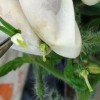Abstract
Hand pollination is a technique that is used for breeding new tomato varieties with desirable characteristics such as plant vigor, disease resistance, and uniform fruit quality and plant growth; since tomatoes have complete flowers and are self-pollinated, it usually is unnecessary to hand pollinate the flowers for fruit production. This 4-page guide illustrates selection and emasculation of flowers from the plant receiving pollen, pollen collection and drying, and pollination of the stigma. Written by Monica Ozores-Hampton, and published by the UF Department of Horticultural Sciences, August 2014. (Photo credit: Monica Ozores-Hampton)
References
Chetelat R. and S. Peacock. 2013. "Guidelines for emasculating and pollinating tomatoes." Univ. California, Davis, Tomato Genet. Resource Ctr. http://tgrc.ucdavis.edu/Guidelines_Emasculating_and_Pollinating_Tomatoes.pdf.
Contreras, S. 2006. "Tomato and Pepper-Seed Biology." Ponificia Univ. Catolica of Chile, Dept. Sci. Veg. http://seedbiology.osu.edu/HCS630_files/May%2017/tomato%20and%20pepper,%20text.pdf.
Delahaut, K. A. and A. C. Newenhouse. 1997. "Growing tomatoes, peppers, and eggplants in Wisconsin: a guide for fresh-market growers." Univ. Wisconsin, Coop. Ext. http://learningstore.uwex.edu/assets/pdfs/a3687.pdf.
Lerner, B. R. and P. Hirst. 2002. "Pollination of fruits and nuts." Purdue Univ. Coop. Ext. Serv. HO-174-W. http://www.hort.purdue.edu/ext/ho-174.pdf.
McCrea S. 2005. "Why blossoms of some vegetables fail to set fruit." Washington State Univ. Spokane County Ext. http://www.spokane-county.wsu.edu/Spokane/eastside/Fact%20Sheets/C148%20Why%20Blossoms%20Fail%20%2005.pdf.
Ozores-Hampton, M., K. Fnu, and G. McAvoy. 2012. "Blossom drop, reduced fruit set and post-pollination disorders in tomato." Univ. Florida, Inst. Food and Agri. Sci. HS1195. http://edis.ifas.ufl.edu/hs1195. https://doi.org/10.32473/edis-hs1195-2012
Rai, N. and Rai, M. 2006. Heterosis breeding in vegetable crops. New Delhi, India: New India Publishing Agency.
Snyder, R. G. 2010. Greenhouse tomato handbook. Mississippi St. Univ. Ext. Srv. http://msucares.com/pubs/publications/p1828.pdf
Warmund, M. R. 2002. "Pollinating fruit crops." Univ. Missouri. Ext. G6001. http://extension.missouri.edu/p/g6001.
Whiting D., C. O'Meara, and C. Wilson. 2012. "Growing Tomatoes." Colorado State Univ. Ext. http://www.ext.colostate.edu/mg/gardennotes/717.html#pollination.

